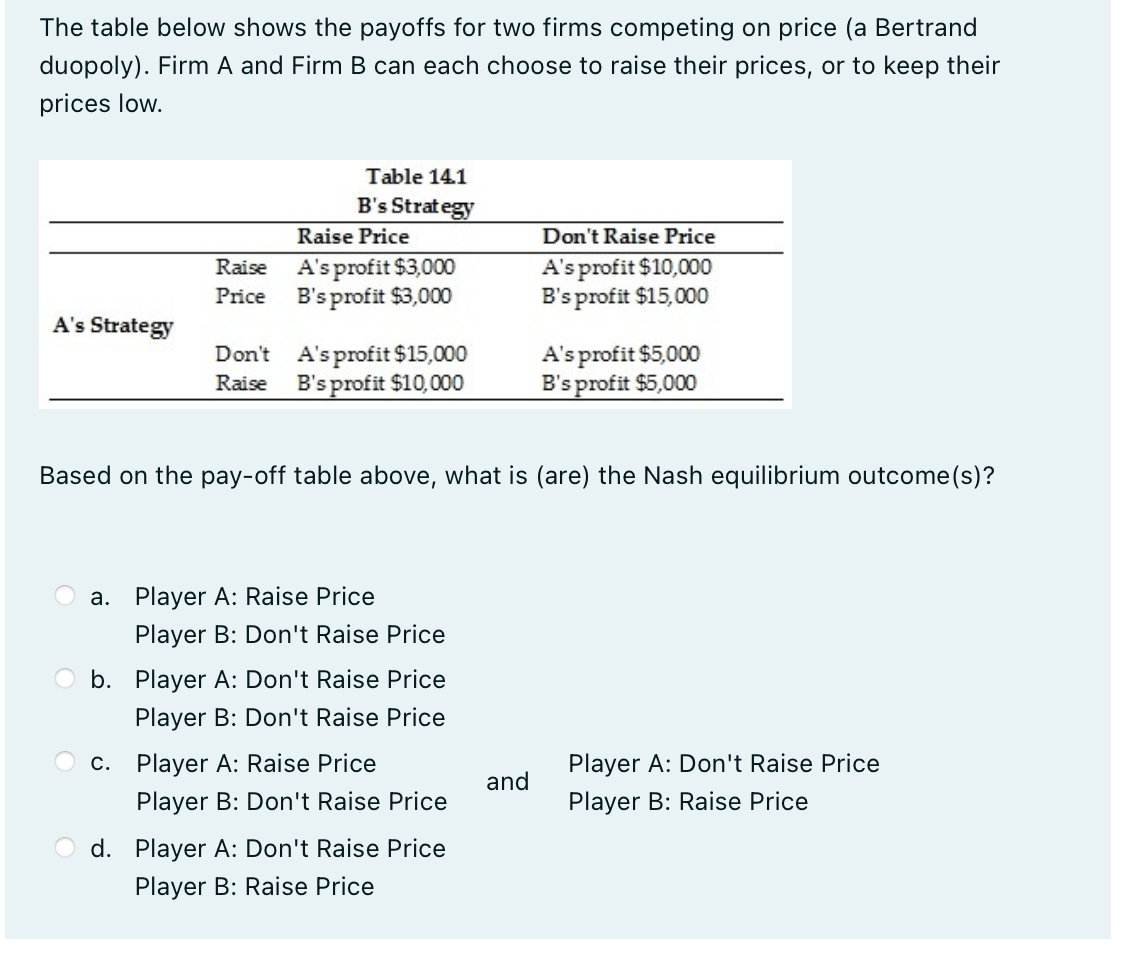The table below shows the payoffs for two firms competing on price (a Bertrand duopoly). Firm A and Firm B can each choose to raise their prices, or to keep their prices low. A's Strategy Raise Price Table 14.1 B's Strategy Raise Price A's profit $3,000 B's profit $3,000 Don't A's profit $15,000 Raise B's profit $10,000 a. Player A: Raise Price Player B: Don't Raise Price b. Player A: Don't Raise Price Player B: Don't Raise Price c. Player A: Raise Price Player B: Don't Raise Price d. Player A: Don't Raise Price Player B: Raise Price Don't Raise Price A's profit $10,000 B's profit $15,000 Based on the pay-off table above, what is (are) the Nash equilibrium outcome(s)? and A's profit $5,000 B's profit $5,000 Player A: Don't Raise Price Player B: Raise Price
The table below shows the payoffs for two firms competing on price (a Bertrand duopoly). Firm A and Firm B can each choose to raise their prices, or to keep their prices low. A's Strategy Raise Price Table 14.1 B's Strategy Raise Price A's profit $3,000 B's profit $3,000 Don't A's profit $15,000 Raise B's profit $10,000 a. Player A: Raise Price Player B: Don't Raise Price b. Player A: Don't Raise Price Player B: Don't Raise Price c. Player A: Raise Price Player B: Don't Raise Price d. Player A: Don't Raise Price Player B: Raise Price Don't Raise Price A's profit $10,000 B's profit $15,000 Based on the pay-off table above, what is (are) the Nash equilibrium outcome(s)? and A's profit $5,000 B's profit $5,000 Player A: Don't Raise Price Player B: Raise Price
Principles of Economics (MindTap Course List)
8th Edition
ISBN:9781305585126
Author:N. Gregory Mankiw
Publisher:N. Gregory Mankiw
Chapter17: Oligopoly
Section: Chapter Questions
Problem 5CQQ
Related questions
Question

Transcribed Image Text:The table below shows the payoffs for two firms competing on price (a Bertrand
duopoly). Firm A and Firm B can each choose to raise their prices, or to keep their
prices low.
A's Strategy
Raise
Price
Table 14.1
B's Strategy
Raise Price
A's profit $3,000
B's profit $3,000
Don't
A's profit $15,000
Raise B's profit $10,000
C.
a. Player A: Raise Price
Based on the pay-off table above, what is (are) the Nash equilibrium outcome(s)?
Player B: Don't Raise Price
b. Player A: Don't Raise Price
Player B: Don't Raise Price
Player A: Raise Price
Player B: Don't Raise Price
d. Player A: Don't Raise Price
Player B: Raise Price
Don't Raise Price
A's profit $10,000
B's profit $15,000
and
A's profit $5,000
B's profit $5,000
Player A: Don't Raise Price
Player B: Raise Price
Expert Solution
This question has been solved!
Explore an expertly crafted, step-by-step solution for a thorough understanding of key concepts.
This is a popular solution!
Trending now
This is a popular solution!
Step by step
Solved in 2 steps

Knowledge Booster
Learn more about
Need a deep-dive on the concept behind this application? Look no further. Learn more about this topic, economics and related others by exploring similar questions and additional content below.Recommended textbooks for you

Principles of Economics (MindTap Course List)
Economics
ISBN:
9781305585126
Author:
N. Gregory Mankiw
Publisher:
Cengage Learning

Principles of Economics, 7th Edition (MindTap Cou…
Economics
ISBN:
9781285165875
Author:
N. Gregory Mankiw
Publisher:
Cengage Learning

Principles of Microeconomics (MindTap Course List)
Economics
ISBN:
9781305971493
Author:
N. Gregory Mankiw
Publisher:
Cengage Learning

Principles of Economics (MindTap Course List)
Economics
ISBN:
9781305585126
Author:
N. Gregory Mankiw
Publisher:
Cengage Learning

Principles of Economics, 7th Edition (MindTap Cou…
Economics
ISBN:
9781285165875
Author:
N. Gregory Mankiw
Publisher:
Cengage Learning

Principles of Microeconomics (MindTap Course List)
Economics
ISBN:
9781305971493
Author:
N. Gregory Mankiw
Publisher:
Cengage Learning

Principles of Economics 2e
Economics
ISBN:
9781947172364
Author:
Steven A. Greenlaw; David Shapiro
Publisher:
OpenStax

Exploring Economics
Economics
ISBN:
9781544336329
Author:
Robert L. Sexton
Publisher:
SAGE Publications, Inc

Economics: Private and Public Choice (MindTap Cou…
Economics
ISBN:
9781305506725
Author:
James D. Gwartney, Richard L. Stroup, Russell S. Sobel, David A. Macpherson
Publisher:
Cengage Learning